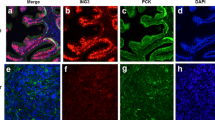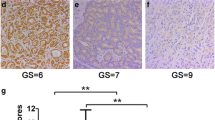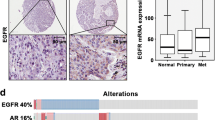Abstract
ETS gene fusions involving ERG, ETV1, ETV4, ETV5, and FLI1 define a distinct class of prostate cancer (PCa), and this might have a bearing on diagnosis, prognosis, and rational therapeutic targeting. In the current study, we focused on the clinicopathological significance of ETV4 in Chinese PCa patients and the mechanisms whereby ETV4 overexpression mediates tumor invasion in the prostate. Overall, ETV4 overexpression was identified in 30.4 % (45/148) of PCa cases by immunohistochemistry. Accordingly, ETV4 was rearranged in only 1.6 % (2/128) of PCa patients. Clinically, ETV4 overexpression was significantly correlated with Gleason score (P = 0.045) and pathological tumor stage (P = 0.041). Multivariate Cox regression analysis indicated that ETV4 is an unfavorable independent prognostic factor (P = 0.040). Functional studies further showed that small interfering RNA (siRNA) knockdown of ETV4 significantly decreases proliferation and invasion of PC-3 cell and partially reverses epithelial-mesenchymal transition in vitro. Notably, ETV4 knockdown significantly downregulated expression of urokinase plasminogen activator (uPA) and its receptor (uPAR) at messenger RNA (mRNA) and protein levels. Chromatin immunoprecipitation assay demonstrated that ETV4 regulates uPA expression through direct binding to its promoter region. Additionally, ETV4 knockdown was also observed to significantly inhibit expression of matrix metalloproteinase (MMP)-2 and MMP-9. In conclusion, for the first time, our study suggested that ETV4 is an independent poor prognostic factor in Chinese PCa patients. Silencing of ETV4 suppresses invasion of PCa cells by inhibiting the expression of uPA/uPAR as well as MMPs. Further studies will be needed to determine whether ETV4 could be regarded as a potential target for the management and prevention of PCa.




Similar content being viewed by others
References
Tomlins SA, Rhodes DR, Perner S, Dhanasekaran SM, Mehra R, Sun XW, et al. Recurrent fusion of TMPRSS2 and ETS transcription factor genes in prostate cancer. Science. 2005;310(5748):644–8.
Kumar-Sinha C, Tomlins SA, Chinnaiyan AM. Recurrent gene fusions in prostate cancer. Nat Rev Cancer. 2008;8(7):497–511.
Han B, Mehra R, Dhanasekaran SM, Yu J, Menon A, Lonigro RJ, et al. A fluorescence in situ hybridization screen for E26 transformation-specific aberrations: identification of DDX5-ETV4 fusion protein in prostate cancer. Cancer Res. 2008;68(18):7629–37.
Keld R, Guo B, Downey P, Gulmann C, Ang YS, Sharrocks AD. The ERK MAP kinase-PEA3/ETV4-MMP-1 axis is operative in oesophageal adenocarcinoma. Mol Cancer. 2010;9:313.
Nosho K, Yoshida M, Yamamoto H, Taniguchi H, Adachi Y, Mikami M, et al. Association of Ets-related transcriptional factor E1AF expression with overexpression of matrix metalloproteinases, COX-2 and iNOS in the early stage of colorectal carcinogenesis. Carcinogenesis. 2005;26(5):892–9.
Yuen HF, Chan YK, Grills C, McCrudden CM, Gunasekharan V, Shi Z, et al. Polyomavirus enhancer activator 3 protein promotes breast cancer metastatic progression through Snail-induced epithelial-mesenchymal transition. J Pathol. 2011;224(1):78–89.
Tomlins SA, Mehra R, Rhodes DR, Smith LR, Roulston D, Helgeson BE, et al. TMPRSS2:ETV4 gene fusions define a third molecular subtype of prostate cancer. Cancer Res. 2006;66(7):3396–400.
Hermans KG, Bressers AA, van der Korput HA, Dits NF, Jenster G, Trapman J. Two unique novel prostate-specific and androgen-regulated fusion partners of ETV4 in prostate cancer. Cancer Res. 2008;68(9):3094–8.
Hollenhorst PC, Paul L, Ferris MW, Graves BJ. The ETS gene ETV4 is required for anchorage-independent growth and a cell proliferation gene expression program in PC3 prostate cells. Genes Cancer. 2011;1(10):1044–52.
Pellecchia A, Pescucci C, De Lorenzo E, Luceri C, Passaro N, Sica M, et al. Overexpression of ETV4 is oncogenic in prostate cells through promotion of both cell proliferation and epithelial to mesenchymal transition. Oncogenesis. 2012;1:e20.
Maruta S, Sakai H, Kanda S, Hayashi T, Kanetake H, Miyata Y. E1AF expression is associated with extra-prostatic growth and matrix metalloproteinase-7 expression in prostate cancer. APMIS. 2009;117(11):791–6.
Hakuma N, Kinoshita I, Shimizu Y, Yamazaki K, Yoshida K, Nishimura M, et al. E1AF/PEA3 activates the Rho/Rho-associated kinase pathway to increase the malignancy potential of non-small-cell lung cancer cells. Cancer Res. 2005;65(23):10776–82.
Aytes A, Mitrofanova A, Kinkade CW, Lefebvre C, Lei M, Phelan V, et al. ETV4 promotes metastasis in response to activation of PI3-kinase and Ras signaling in a mouse model of advanced prostate cancer. Proc Natl Acad Sci U S A. 2013;110(37):E3506–15.
Kumano M, Miyake H, Muramaki M, Furukawa J, Takenaka A, Fujisawa M. Expression of urokinase-type plasminogen activator system in prostate cancer: correlation with clinicopathological outcomes in patients undergoing radical prostatectomy. Urol Oncol. 2009;27(2):180–6.
Oikawa T. ETS transcription factors: possible targets for cancer therapy. Cancer Sci. 2004;95(8):626–33.
Evans CP, Stapp EC, Dall'Era MA, Juarez J, Yang JC. Regulation of u-PA gene expression in human prostate cancer. Int J Cancer. 2001;94(3):390–5.
Hua H, Li M, Luo T, Yin Y, Jiang Y. Matrix metalloproteinases in tumorigenesis: an evolving paradigm. Cell Mol Life Sci. 2011;68(23):3853–68.
Gong Y, Chippada-Venkata UD, Oh WK. Roles of matrix metalloproteinases and their natural inhibitors in prostate cancer progression. Cancers (Basel). 2014;6(3):1298–327.
Qi M, Yang X, Zhang F, Lin T, Sun X, Li Y, et al. ERG rearrangement is associated with prostate cancer-related death in Chinese prostate cancer patients. PLoS One. 2014;9(2):e84959.
Wang L, Zhang J, Yang X, Chang YW, Qi M, Zhou Z, et al. SOX4 is associated with poor prognosis in prostate cancer and promotes epithelial-mesenchymal transition in vitro. Prostate Cancer Prostatic Dis. 2013;16(4):301–7.
Wang C, Wang L, Su B, Lu N, Song J, Yang X, et al. Serine protease inhibitor Kazal type 1 promotes epithelial-mesenchymal transition through EGFR signaling pathway in prostate cancer. Prostate. 2014;74(7):689–701.
Wang L, Li Y, Yang X, Yuan H, Li X, Qi M, et al. ERG-SOX4 interaction promotes epithelial-mesenchymal transition in prostate cancer cells. Prostate. 2014;74(6):647–58.
Thiery JP, Sleeman JP. Complex networks orchestrate epithelial-mesenchymal transitions. Nat Rev Mol Cell Biol. 2006;7(2):131–42.
Shariat SF, Roehrborn CG, McConnell JD, Park S, Alam N, Wheeler TM, et al. Association of the circulating levels of the urokinase system of plasminogen activation with the presence of prostate cancer and invasion, progression, and metastasis. J Clin Oncol. 2007;25(4):349–55.
Dass K, Ahmad A, Azmi AS, Sarkar SH, Sarkar FH. Evolving role of uPA/uPAR system in human cancers. Cancer Treat Rev. 2008;34(2):122–36.
Xing X, Wang SC, Xia W, Zou Y, Shao R, Kwong KY, et al. The ets protein PEA3 suppresses HER-2/neu overexpression and inhibits tumorigenesis. Nat Med. 2000;6(2):189–95.
Clementz AG, Rogowski A, Pandya K, Miele L, Osipo C. NOTCH-1 and NOTCH-4 are novel gene targets of PEA3 in breast cancer: novel therapeutic implications. Breast Cancer Res. 2011;13(3):R63.
Li C, Zhang J, Jiang Y, Gurewich V, Chen Y, Liu JN. Urokinase-type plasminogen activator up-regulates its own expression by endothelial cells and monocytes via the u-PAR pathway. Thromb Res. 2001;103(3):221–32.
Noh H, Hong S, Huang S. Role of urokinase receptor in tumor progression and development. Theranostics. 2013;3(7):487–95.
Acknowledgments
Supported by the National Natural Science Foundation of China (Grant No. 81171951); China Postdoctoral Science Foundation Funded Project (Project No. 2012 M521344); Natural Science Foundation of Shandong Province (Grant No. ZR2011HQ040),
Conflicts of interest
None
Author information
Authors and Affiliations
Corresponding author
Additional information
Qi M. and Liu Z. contributed to this work equally.
Electronic supplementary material
Below is the link to the electronic supplementary material.
ESM 1
(XLS 26 kb)
ESM 2
(XLS 27 kb)
Supplementary Fig. 1
The alteration of uPA and uPAR mRNA level in PC-3 cells. The uPA and uPAR mRNA levels after exposure of 10ng/ml rUPA was quantified by qRT-PCR in PC-3 cells after ETV4 silencing (*p<0.05, compared to the control). Con, control group; rUPA, recombinant uPA protein (GIF 9 kb)
Rights and permissions
About this article
Cite this article
Qi, M., Liu, Z., Shen, C. et al. Overexpression of ETV4 is associated with poor prognosis in prostate cancer: involvement of uPA/uPAR and MMPs. Tumor Biol. 36, 3565–3572 (2015). https://doi.org/10.1007/s13277-014-2993-7
Received:
Accepted:
Published:
Issue Date:
DOI: https://doi.org/10.1007/s13277-014-2993-7




